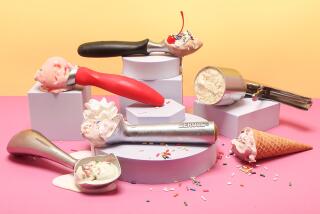Old-Fashioned Siphon Bottles Back in Vogue
- Share via
Many household gadgets that have been around for decades are rediscovered through trends in food and physical fitness as well as social and travel influences. Surfacing back on store shelves now are old-fashioned siphon bottles, in fashionable colors, including soda siphons and cream siphons or whipping cream whippers.
Soda siphons bring back memories of old comedy movies. Remember watching silly comedians squirting seltzer drinks at each other? As far back as 1855 in London, the first pint-size siphon bottle emerged, introduced by Sparklets Ltd. Reinforced with a wire-mesh covering, the Sparklet siphon carbonated fresh water by discharging compressed carbon dioxide gas into it from a small cylinder.
“The ubiquitous seltzer siphon,” wrote Nicholas Pileggi in the New York World Journal Tribune many years ago, “was a kitchen table staple in the boyhood apartments of future governors, senators and merchant millionaires. . . . Seltzer was not a luxury. It was the only palatable, non-dyspeptic, poison-free drinking water available.”
Sales Perk Up
Today, the trend toward healthful, sparkling water or natural beverages with no salt, no chemical additives and no calories has helped perk up sales of soda siphons. Another trend that has brought them back to the home bars is an increasing demand for lighter and more refreshing alcoholic drinks like wine coolers and spritzers as well as non-alcoholic sparkling drinks.
Influenced by European travels, Americans are also discovering shandy, a drink made by adding carbonated water and fruit flavors to beer or beer substitutes. And, of course, many will find an excuse to use the siphon for ice cream sodas, done by squirting carbonated water into a tall glass of ice cream.
To use the soda siphon, pour cold water or other liquid to be carbonated into the canister. Close the canister, insert the carbon dioxide charger, shake vigorously and press the lever. Small carbon dioxide cartridges, which are easily available, come in boxes of 10 or 20 and will fit all standard soda siphons.
The soda siphon produces delicious bubbly cranberry juice and works well with other clear, smooth juices and cider (avoid juices with pulp). If living in areas where the water has a high mineral content, use bottled pure water to avoid clogging. The carbonated drink may be left in the canister and stored in the refrigerator for several days.
Cream siphons re-entered the market much later than their soda counterpart. When gourmet coffee, French pastries and ice cream sundaes resurfaced in popularity, whipped cream also floated up, as did cream dispensers.
Mess-Free
The siphon, which uses nitrogen oxide cartridges, is a mess-free way of whipping cream. The cream siphon works easily in seconds. Pour the cream into the bottle, close and insert the cartridge. Shake once or twice and press the trigger to produce pretty rosettes of cream. After whipping, the cream may be conveniently left in the canister and stored in the refrigerator to be used as needed.
The whipping cream may be sweetened with powdered sugar, if desired. For more interesting flavors, a little liqueur, powdered coffee or chocolate may be added and dissolved into the cream before whipping. If the cream will be left to stand for some time, a small amount of unflavored gelatin or powdered egg white, which works as a stabilizer, may be added before whipping.
A little milk or half-and-half stirred in before whipping will also produce a lighter and smoother cream. To prevent curdling, avoid shaking the canister too much.
Buying a soda or whipped cream siphon is comparable to buying a dress or fashion accessory item. Although the siphons compete in quality of material and color, some exhibiting splashy metallic designs of bright colors, floral prints or striping, they are basically similar in shape design and function. But depending on the make and import source, the cost varies.
The products are imported from different European countries--the Merkuria siphon from American Cut Crystal comes from Czechoslovakia; the Isi siphons from Isi Siphon of America come from Austria; Eva Housewares Inc. siphons come from West Germany; the Sodamaster from Leland Limited comes from West Germany, and the Lethel Autosyphon and Pro-Whip come from Lehelex Co. in Hungary.
In the lower-price bracket is the Isi siphon, whereas on the high end is Merkuria. This is the modern version of the oldest glass siphon bottle with the wire-mesh covering (now a collector’s item), which is made of a crystal bottle enveloped in a polished chrome mesh.
Directions Complicated
Many first-time buyers become frustrated with European instructions and intricate illustrations for assembling and using siphons. For some reason, European directions seem more complicated than necessary. However, most siphons are easy to use and are available assembled; some come with extra parts like washers and screws. Some siphons also have added features: The Pro-Whip, for instance, comes with three decorating tips. Isi’s cream siphon comes with a recipe for making mayonnaise.
The soda and whipped cream siphons (1-quart capacity) range in price from $19.95 to $58.50 and are available in specialty cookware stores such as Williams-Sonoma, Gelson’s and other stores such as Buffums , Bullock’s and Geary’s.
More to Read
Eat your way across L.A.
Get our weekly Tasting Notes newsletter for reviews, news and more.
You may occasionally receive promotional content from the Los Angeles Times.










